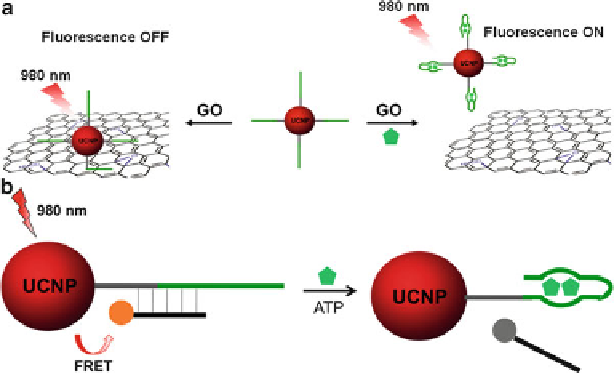Biomedical Engineering Reference
In-Depth Information
Fig. 13.9
Schematic of aptamer-UCNPs biosensor for ATP detection based on the upconversion
FRET from (
a
)UCNPstoGOand(
b
) UCNPs to organic dye
in zero background absorption and suppression of autofluorescence [
114
-
122
].
The large anti-Stokes shift and narrow emission bands enable easy separation of
the discrete emission peaks from the excitation light [
114
,
115
]. Furthermore, in
contrast to organic fluorophores and QDs, UCNPs exhibit neither photoblinking
nor photobleaching even with hours of continuous excitation, and their rare earth
components are much less toxic than the heavy metals within QDs [
114
,
115
]. Due
to their attractive optical and chemical features, UCNPs have become an interesting
probe for sensing and bioimaging. By now, various UCNPs-based sensors have been
constructed for the detection of protein [
123
,
124
], DNA [
125
,
126
], and metal
ion [
127
].
By using aptamer-modified NaYF
4
:Yb/Er UCNPs as energy donors and
graphene oxide (GO) as energy acceptors, Li et al. have developed a sensitive
FRET sensor for detection of ATP (Fig.
13.9
a) [
128
]. The absorption spectrum
of GO overlaps well with the fluorescence emission of UCNPs. While aptamer-
UCNPs were incubated with GO, the aptamer-UCNPs could be brought in close
proximity to the GO surface through the strong
stacking interaction between
DNA and GO, resulting in quenched fluorescence of UCNPs due to the FRET.
In the presence of ATP, the specific binding of ATP with its aptamer lead to the
formation of a rigid aptamer-ATP structure conformation and therefore decreased
the interaction between DNA and GO, resulting in the release of UCNPs and thus
enhanced upconversion fluorescence. The sensor showed a detection limit of 80 nM
and had high selectivity. Based on a similar design, Pang et al. developed an aptamer
biosensor for protein based on FRET from UCNPs to carbon nanoparticles [
129
].
The sensor provided a detection limit of 0.18 nM in an aqueous buffer and 0.25 nM
in human serum samples, indicating high robustness of the sensor in a complicated
biological sample.
-

Search WWH ::

Custom Search